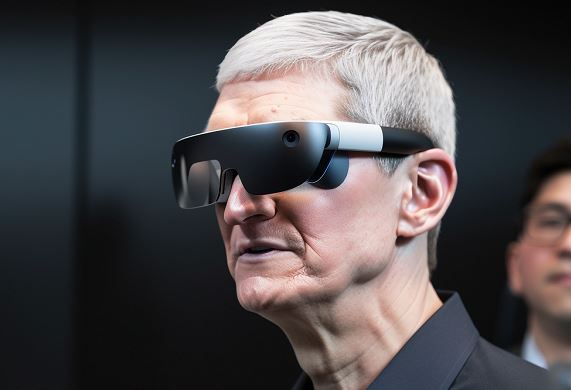Difficult situation with Apple headsets | |

| |
The headset is said to boast a "non-traditional curved design, slimness, and ultra-lightweight." Several renders seen by The Information "depict a piece of curved glass with edges wrapped in a smooth aluminum frame, which appears slightly thicker than an iPhone." The slim profile necessitates users who wear glasses to purchase prescription lenses that attach magnetically to the headset. Apple had to develop a first-of-its-kind "curved motherboard" to fit inside the curved external shell of the headset. Carbon fiber is used inside the headset to reinforce the structure without adding extra weight. A small disc is positioned above the right eye, allowing users to switch between augmented and virtual reality, while the power button is located above the left eye. A round connector, resembling an Apple Watch charger, attaches to the left temple of the headset and descends via a cable to a battery worn on the waist. The headset's headband is predominantly made of soft material and is attached to two short rigid arms, which also house the left and right speakers. A soft detachable cover is attached to the rear of the headset for a comfortable fit against the user's face. Apple is said to have discussed the possibility of adding additional eye-tracking cameras or additional motorized lens adjustments to accommodate a greater range of facial shapes. The Apple industrial design team insisted on using thin curved glass for the front of the headset, which required concealing over a dozen cameras and sensors for aesthetic reasons. Concerns were raised that the glass may distort images captured by the cameras, potentially causing nausea, and the material is more susceptible to breakage than an iPhone screen due to its shape. Broken glass could pose a risk to users. The design is said to be a significant factor in determining the retail price of the device, which is estimated to be around $3,000. Assemblers have struggled to install components at inconvenient angles inside the device due to its shape and densely packed electronics. Testing the glass casing and cameras also takes much longer compared to similar processes for other Apple devices. It is also rumored that the microOLED displays for the headset are so expensive that Apple has to repair defective units rather than discard them. Sony, the display supplier, may encounter difficulties in producing an adequate number of panels for over 250,000 headsets this year due to their small size and pixel density. During the earlier stages of Apple's development, they were producing 100 headsets per day, but only 20 units met the company's standards. In mid-April, the headset underwent a design verification process, reportedly taking an unusually long time compared to more mature products like the iPhone. Apple apparently made exceptionally late design changes as early as April to streamline production. While mass production of the headset has not yet begun, Luxshare, its sole manufacturer, allegedly informed workers that the factory responsible for producing the headset should be fully staffed by July. The Information speculates that this indicates a launch in the fall or winter. It is expected that Apple will ship fewer than half a million headsets during the first year of their release. | |
| Category: Technology | Views: 109 | | |
| Total comments: 0 | |
No entries.